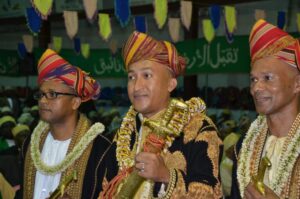Discover the history of Comoros
A Fascinating History of Migration
The Comoro Islands have been populated by successive arrivals of people of diverse origins. However, its early settlement is still shrouded in mystery. Who first set foot on the volcanic islands? How did they get here and when? The early history of the Comoros, being based more on oral tradition and legends than on written sources, leaves the answers to these questions an enigma.
The islands were first been explored and documented by Arab and Persian traders crossing the Mozambique channel. However, it is widely accepted by historians that the first inhabitants of the Comoros were African. Belonging to the Bantu group of peoples, they would have originated from East Africa between the 5th and the 7th centuries, before somehow travelling more than 200 km from the mainland.
It is also believed that there was an ancient Asian settlement in the Comoros around the 9th century. Austronesians from Southeast Asia making their voyages to the western edge of the Indian Ocean in traditional canoes would have settled in Madagascar and the Comoros. Archaeological discoveries and cultural elements such as the use of outrigger canoes, sugar cane, bananas and coconuts reveal similarities with Southeast Asian culture

The Land of Sultans
Coming from the city of Shiraz in Persia (modern Iran), the first Shirazis, probably arrived on the islands in the 10th century. It is known that the Sultan of Shiraz, named Ali Ben Hassan, had established vast sultanates that included territories including the Comoros, Zanzibar and part of Madagascar.
They established trade relations with other countries along the Indian Ocean and developed a thriving economy based on the sale of spices and slaves. From the 16th century, the Arabo-Shirazi set up a Shirazi aristocracy: they controlled the port activities, forged alliances with the local chiefs by marrying their daughters, and formed clans which gradually become Sultanates. The society was organized into classes, with an elite of Shirazi sultans, a middle class of free persons, and then lower class slaves. The Shirazis also established Sunni islam as the dominant religion in the islands. They built the first stone mosque in Anjouan, at Sima, in 1566.
Rivalries between the Sultans gave rise to frequent military expeditions from one island to the other, so that the Comoros became known as the “archipelago of the fighting sultans”.
In the early 15th century, the Portuguese explorer Vasco de Gama landed on Grande Comore, and in 1527, the Comoro Islands appeared on a world map drawn by Portuguese cartographer Diego Ribero. The Portuguese settled for a short time in Grande Comore before leaving for good. They did not leave a lasting legacy on the Comorian society, likely due to the established presence of the Shirazi sultans.
Pirates and Raiders
In the 17th and 18th centuries, pirates from Madagascar and Europe lurked in the Comoros and used the islands as a base from which to attack and rob merchant vessels on the East India routes. In 1697 the notorious Captain Kidd arrived. After first calling at the preferred port in Anjouan, he chose to move over to Mohéli to avoid prying eyes. Here he beached his ship, the Adventure Galley, in order to effect repairs. While there, his crew of 150 men were taken ill and more than 40 of them were buried under the coconut palms of Mohéli. It was only a few months after departing Comoros that he attacked an Indian ship and captured his most famous treasure, resulting in his eventual trial and execution for piracy, and numerous legends regarding the location of the stolen plunder.
Beginning in 1785, the Sakalava of the west coast of Madagascar began regular raids on the islands. These raids were mounted about every five years and consisted of hundreds of ships which captured thousands of Comorians who were then carried off to be sold in French-occupied Madagascar, Mauritius, or Reunion to work on the sugar plantations. The city of Domoni was completely destroyed by Malagasy pirates and in 1805 they led a large incursion on the capital city of Iconi. Ramparts and forts were built along the Comorian coasts to defend the country.
From French Protectorate and Colony to Independence
These slave raids, which decimated the islands, incited the sultans to seek the protection of the European powers. In 1841, the French started negotiations in Mayotte which led to the signing of a treaty to form the Protectorate of Mayotte. From 1841 to 1886, the agreement grew to include all four islands. In 1912, the Comoros were declared to be a colony of France and attached administratively to Madagascar. At the end of World War II, the islands were given financial and administrative autonomy and representation in the French legislature. Complete administrative authority was granted to the islands in 1961, and a domestic government was established.
In the late 1960s and continuing through the early 1970s, pressures grew in the Comoros for independence from France. In 1974, majorities on Grande Comore, Mohéli, and Anjouan voted for independence, while the population of Mayotte voted to stay under French rule. On July 6 1975, Ahmed Abdallah Abderemane (elected president of the Comorian Government in 1972 when the archipelago was still under French rule) declared the whole archipelago independent and became the country’s first president. However, France rejected Comoros’ claim to Mayotte, which still remains under French administration to this day.

